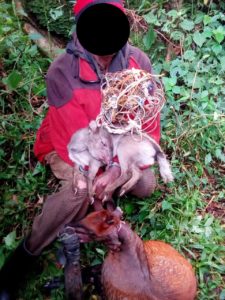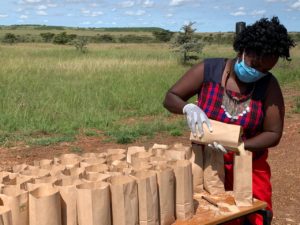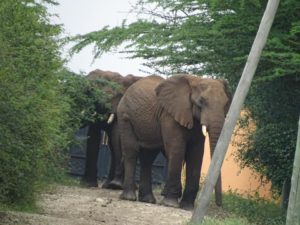The second quarter brought about many challenges for Mara Elephant Project due to the changing landscape in the Mara because of COVID-19. MEP is continuing our strict COVID-19 protocols and they are starting to become the new normal. MEP rangers stationed in the field are making sure to practice proper safety protocols despite their lack of access to running water. Our ranger stations are using a tippy tap and MEP has also built tippy taps for rangers at Mara North Conservancy. Additionally, we felt it was important to ensure the local community had access, so we built tippy taps in the neighboring community Manyatta and at the entrance to Mara Elephant Project headquarters.
 The halt of tourist generated revenue in the Mara has meant more people are out of work, which results in food insecurity and an increase in illegal activities. As projected, we are starting to see concrete evidence that bushmeat poaching and habitat destruction activities are on the rise. In June, we recorded the highest number of illegal bushmeat poaching and logging incidents since the inception of MEP and continuing the protection of the Mara’s wildlife, communities and habitat alongside partners is crucial right now. pictured left: One suspect was arrested on June 20 in the Mau Forest by the Sheldrick Wildlife Trust Mau De-Snaring Unit with 20 kg of bushmeat. The team removed 21 snares that day in the Mau.
The halt of tourist generated revenue in the Mara has meant more people are out of work, which results in food insecurity and an increase in illegal activities. As projected, we are starting to see concrete evidence that bushmeat poaching and habitat destruction activities are on the rise. In June, we recorded the highest number of illegal bushmeat poaching and logging incidents since the inception of MEP and continuing the protection of the Mara’s wildlife, communities and habitat alongside partners is crucial right now. pictured left: One suspect was arrested on June 20 in the Mau Forest by the Sheldrick Wildlife Trust Mau De-Snaring Unit with 20 kg of bushmeat. The team removed 21 snares that day in the Mau.
MEP is combatting these changes head on by deploying our partnership model and working closely with Kenya Wildlife Service (KWS), Kenya Forest Service (KFS) and Bongo Surveillance Project (BSP) within in the ecosystem. The three forest areas we work in are taking a real hit with the increase in illegal activities and, as a result, we’ve increased our efforts to meet this upsurge all while keeping our rangers safe and working closer than ever with our government law enforcement partners. The Karen Blixen Camp Trust helicopter also assisted in the air by providing reconnaissance of heavily forested areas. In April, we conducted an aerial patrol flight in the Loita Hills and Loita Forest. In the Loita Forest we found Podocarpus trees felled for timber production and relayed the coordinates to the ground teams for follow up. We then proceeded to the Loita Hills southwest of Naroosora Center where several large cedar logging operations were spotted. This information was sent to the MEP human-elephant conflict team based in the area, which quickly mobilized with the police and arrested one suspect and destroyed all of the illegal posts. MEP also conducted an aerial patrol of the Mau Forest where we recorded several illegal logging and charcoal sights. We have not been able to stop all the illegal logging in the forests, but we have certainly had a positive impact on frustrating and breaking down these cartels.
 The weather also didn’t help! April was a very wet month here and it was said locally that the Mara River was as high as at any time in recent memory. pictured left: A MEP ranger demonstrating how high water levels were while on patrol. The main roads and three of the main bridges crossing the Mara River were impassable for a number of days effectively cutting off the Transmara from the Narok side of the county. Unfortunately, this flooding impacted camps alongside the river that were already experiencing difficulties due to the complete loss of tourism as a result of COVID-19. Camps and lodges along the river have been hit hard and even though many had a skeleton staff on hand, the water levels rose so quickly, they needed immediate evacuation. MEP was called in to rescue two camp staff members from Ngerende in the Wild with the helicopter and transport them to safety. It’s not just people that are stranded, elephants too. Collared elephant ‘Fred’ was caught on the western side of the river as it rose and had to spend several weeks waiting for the water levels to subside before crossing back. Additionally, MEP was approached by KWS and Animal Rights Reserved who reported that 30 cape buffalo were stranded on a small island on Lake Naivasha and had run out of food. The two organizations supported the flying time to push the animals to safety and the operation was a great success. We suspect that the rapidly rising lake caught the buffalos off guard and suddenly they found themselves surrounded by water.
The weather also didn’t help! April was a very wet month here and it was said locally that the Mara River was as high as at any time in recent memory. pictured left: A MEP ranger demonstrating how high water levels were while on patrol. The main roads and three of the main bridges crossing the Mara River were impassable for a number of days effectively cutting off the Transmara from the Narok side of the county. Unfortunately, this flooding impacted camps alongside the river that were already experiencing difficulties due to the complete loss of tourism as a result of COVID-19. Camps and lodges along the river have been hit hard and even though many had a skeleton staff on hand, the water levels rose so quickly, they needed immediate evacuation. MEP was called in to rescue two camp staff members from Ngerende in the Wild with the helicopter and transport them to safety. It’s not just people that are stranded, elephants too. Collared elephant ‘Fred’ was caught on the western side of the river as it rose and had to spend several weeks waiting for the water levels to subside before crossing back. Additionally, MEP was approached by KWS and Animal Rights Reserved who reported that 30 cape buffalo were stranded on a small island on Lake Naivasha and had run out of food. The two organizations supported the flying time to push the animals to safety and the operation was a great success. We suspect that the rapidly rising lake caught the buffalos off guard and suddenly they found themselves surrounded by water.

The heavy rain also made the food distribution that The Maa Trust did even more challenging to coordinate. We teamed up with them in late April to distribute food parcels to 637 families donated by the Sidekick Foundation. The women who made high quality beaded items and sold honey to lodges lost their livelihoods overnight due to the loss of tourism. Several national newspapers including The Insider and Talk Africa covered the distribution and The Maa Trust also wrote a blog thanking MEP for our help. This project was funded by our main supporter the Sidekick Foundation and has made a huge difference to these families.
Human-elephant conflict mitigation operations were high during the second quarter due to the increased amount of rain and the traditional crop ripening season. Especially during a time of food insecurity, responding to conflict on the ground and in the helicopter was vital to ensure the community’s food supply was safe. In the Naroosora area of Loita, MEP stationed a ranger team to help prevent crop raiding. In June, tensions in this area were escalated when, on June 16, a young man was killed by an elephant during a conflict incident. The incident became politically charged and one of our rangers was injured on the head by a stone and received medical attention. We pulled our team out of this area for their own safety but more recently, we have had numerous calls from farmers to return to help them protect their farms at night. This area continues to be severely degraded and is extremely sensitive politically as the area is set to be subdivided.
Elephants in the Nyakweri Forest are increasingly threatened, including collared elephant Fitz. They have been engaging in frequent crop raiding activity and a MEP and KWS rapid response team was sent to this area to increase security and respond to conflict. They are responding almost nightly to move the herd back into the forest.
The Karen Blixen Camp Trust helicopter was used to deploy two new elephant collars in response to elephants in high conflict areas. In June, at the request of KWS, Mara Elephant Project collared a bull elephant, Shamba, that was injured after being caught in farms by rapidly rising waters across the Mara River. In addition to his new collar, KWS Vet Dr. Limo and the Sheldrick Wildlife Trust Mara Mobile Vet Unit removed four arrows and treated a spear wound. The satellite collar allowed us to not only monitor his recovery, but also react to his future crop raiding. This area has seen a high level of human-elephant conflict historically because it’s heavily populated with many people farming right across the Mara River from the Ol Choro Oiroua Conservancy, a safe place for elephants to roam. Shamba was monitored until his time of death 10 days later. On June 25, MEP received an immobility alert from his collar and the cause of death was determined by a KWS autopsy as most likely thromboembolism from the originally treated spear wound on his chest. While the team’s joint efforts to treat and collar this elephant to save his life weren’t successful this time, if the elephant had not been collared, we wouldn’t have gotten to the carcass quickly enough to identify the cause of death; an important data point to collect in the Mara to protect future elephants. The MEP team was able to recover Shamba’s elephant collar to re-deploy this year. Shamba’s story, while sad, represents a common one told in the Mara; the struggle between elephants and farmers continues. This is why KWS and MEP believe that collaring key elephant candidates in response to conflict is a successful approach in order to monitor their movements in real-time and collect important data for land use planning.
The second collaring MEP did was requested by KWS in response to conflict as well. In the Londiani area north of the Mau, “Ritan” was identified as a cropaholic elephant; going into farms around Deloraine on a nightly basis. The KWS ground team based in the area was vigilant about pushing him back into the forest when he breaks through the geo-fence we programmed around the forest. The collaring operation was an interesting exercise for the Karen Blixen Camp Trust helicopter as hovering at high altitudes during the darting pushes the helicopter to the edge of the power envelope. The mission was a great success and completed without incident.
 Finally, we must end with a rather exciting event that made national news in May. On May 17, three bull elephants traveled, we think, from Mosiro in the Rift Valley, to the outskirts of Nairobi. This event had people posting all over social media. Some were seeing elephants for the first time in their lives, others were teasing that the elephants do not respect the lockdown, and some were worried about the landowner and elephant’s safety. KWS was quick to respond and translocate the three bulls to the Maasai Mara National Reserve. They also collared one of the bulls in partnership with Save the Elephants and the collared animal is now also on our system and is currently in the MMNR. pictured left: Elephants in Nairobi photographed by residents and posted on social media.
Finally, we must end with a rather exciting event that made national news in May. On May 17, three bull elephants traveled, we think, from Mosiro in the Rift Valley, to the outskirts of Nairobi. This event had people posting all over social media. Some were seeing elephants for the first time in their lives, others were teasing that the elephants do not respect the lockdown, and some were worried about the landowner and elephant’s safety. KWS was quick to respond and translocate the three bulls to the Maasai Mara National Reserve. They also collared one of the bulls in partnership with Save the Elephants and the collared animal is now also on our system and is currently in the MMNR. pictured left: Elephants in Nairobi photographed by residents and posted on social media.


